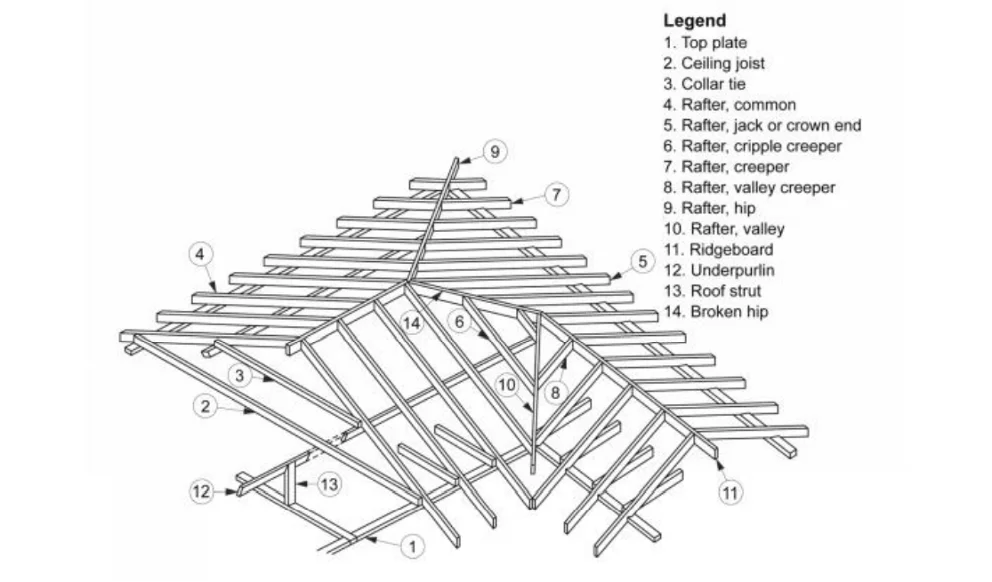Typical Roof Framing Terms In The Building Code Australia (BCA)
This article describes the typical roof framing terms in the BCA . Being aware of each element is crucial in understanding the composition of complex residential roofs and the processes involved in their construction.

Note. From Typical roof framing members terms in BCA, by Australian Building Codes Board. Building Codes Australia. Copyright of Commonwealth of Australia and the States and Territories of Australia 2019.
Typical Roof framing terms
- The top plate: The top plate is a beam that runs the full length atop the walls and is used to support the roof, transferring the forces from the roof to the structure’s frame and into the foundations.
- Ceiling joists: Ceiling joists are horizontal framing members that support the load of the ceiling whilst concurrently stopping the wall frames from bowing out or falling in/outwards. They also serve as the floor framing for the level above or attic.
- Collar ties: Collar ties are horizontal members that are fitted to pairs of rafters to stop them from spreading apart.
- Common Rafters: Common Rafters are members that are typically erected in pairs, meet at the ridge board of the roof, run in the same direction as the roof slope, and support the roof.
- Jack or Crown End Rafters: Jack or Crown End Rafters are members that are fitted to the ends of the ridge board and slope down to match the other rafter slopes. Usually, at both ends of the ridge board, they serve as bracing to strengthen the roof frame.
- Cripple creeper Rafter: A Cripple creeper Rafter is a rafter where one end connects to a broken hip and the other to a valley rafter.
- Creeper Rafters: Creeper Rafters are essentially common rafters, except they meet at a hip rafter rather than the ridge board, thus making them variably shorter.
- Valley Creep Rafter: Valley Creep Rafter is like a creeper rafter except one end is connected to a valley rafter rather than nothing. The other end is still connected to the ridge board.
- Hip Rafter: A Hip Rafter is a member that is connected to the end of the ridge beam, and diagonally extends and slopes towards the intersection between two wall top plates.
- A Valley Rafter: A Valley Rafter is similar to a hip rafter except the end connecting to the ridge board can join anywhere along with the ridge board, not just the end.
- Ridge board: Ridge board is a horizontal member, usually positioned in the centre of the roof span, that the top ends of rafters connect to. It ensures all rafters meet at the same level and are sloping at the same angle.
- Under purlins: Under purlins are horizontal members that lie perpendicular to the roof slope and are positioned under the rafters to help avoid the roof sagging.
- Roof struts: Roof struts transfer the roof load encountered by the under purlins to beams, which then transfer the load to walls.
- Broken hip: The Broken hip connects ridge boards when they are at different levels as a result of differing building spans.
References
Arnold & Brown. (2019). Basic Roof Framing. https://wilswood.weebly.com/uploads/1/6/8/8/16880972/ch17_carpentry_se.pdf
BUILD. (2021). Roof framing elements. https://build.com.au/roof-framing-elements
Building Code of Australia. (2019). National Construction Code – Volume 1 (ABCD). Australian Building Codes Board
Qbis: Carpentry – Housing. (2021). Hip and Valley Roofing. TAFE NSW Construction and Transport Division
